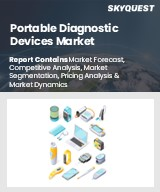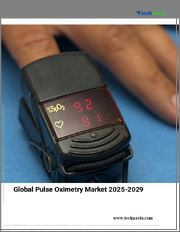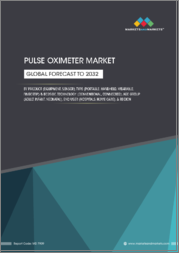
|
시장보고서
상품코드
1504200
맥박 산소 측정기 시장 규모, 점유율, 예측 및 동향 분석 : 구성 요소, 휴대성, 기술, 연령 및 최종 사용자별 - 세계 예측(-2031년)Pulse Oximeter Market Size, Share, Forecast, & Trends Analysis by Component (Device, SPO2 Sensors) Portability (Handheld, Wearable, Fingertip) Technology (Connected, Conventional) Age (Adult, Pediatric) End User - Global Forecast to 2031 |
||||||
맥박 산소 측정기 시장은 2024-2031년간 5.4%의 연평균 복합 성장률(CAGR)로 성장하여 2031년에는 34억 달러에 달할 것으로 예상됩니다.
이 보고서는 종합적인 1차 및 2차 조사, 시장 시나리오에 대한 심층 분석을 바탕으로 업계의 주요 동인, 제약, 도전 과제, 기회를 제공합니다. 입원 환자 수 증가, 신생아 검진에서 맥박 산소 측정기 사용 증가, 만성폐쇄성폐질환(COPD) 및 천식 발병률 증가, OTC 맥박 산소 측정기 보급 확대 등이 이 시장을 주도하고 있습니다.
또한, 맥박 산소 농도계의 기술 발전, 웨어러블 기기의 채택 증가, 센서 기술의 발전은 이 시장에 큰 성장 기회를 가져다주고 있습니다. 그러나 OTC 맥박 산소 농도계와 관련된 데이터 정확도 및 신뢰성 문제와 규제 문제가 이 시장의 성장을 저해할 수 있습니다. 또한, 혈중 산소 농도를 모니터링하기 위한 모바일 기반 대체 기술의 출현은 이 시장에서 사업을 운영하는 기업들에게 큰 도전이 되고 있습니다.
목차
제1장 서론
제2장 조사 방법
제3장 주요 요약
제4장 시장 인사이트
- 개요
- 성장 촉진요인
- 성장 억제요인
- 기회
- 과제
- 동향
- 규제 시나리오
- 가격 분석
- Porter의 Five Forces 분석
제5장 세계의 맥박 산소 측정기 시장 : 컴포넌트별
- 개요
- 디바이스
- 처방 맥박 산소 측정기
- 시판(OTC) 맥박 산소 측정기
- 센서
- 일회용 SpO2 센서
- 재이용 가능 SpO2 센서
제6장 세계의 맥박 산소 측정기 시장 : 휴대성별
- 개요
- 핸드헬드 맥박 산소 측정기
- 손가락끝 맥박 산소 측정기
- 웨어러블 맥박 산소 측정기
- 탁상형 맥박 산소 측정기
제7장 세계의 맥박 산소 측정기 시장 : 기술별
- 개요
- 기존 맥박 산소 측정기
- 커넥티드 맥박 산소 측정기
제8장 세계의 맥박 산소 측정기 시장 : 연령층별
- 개요
- 성인
- 소아
- 태아 모니터링
- 신생아 모니터링
- 유아 모니터링
제9장 세계의 맥박 산소 측정기 시장 : 최종사용자별
- 개요
- 병원 및 진료소
- 재택치료
- 외래 의료 센터
- 기타 최종사용자
제10장 맥박 산소 측정기 시장 : 지역별
- 개요
- 북미
- 미국
- 캐나다
- 유럽
- 독일
- 프랑스
- 영국
- 이탈리아
- 스페인
- 스위스
- 아일랜드
- 덴마크
- 벨기에
- 기타 유럽
- 아시아태평양
- 중국
- 일본
- 인도
- 한국
- 기타 아시아태평양
- 라틴아메리카
- 브라질
- 멕시코
- 기타 라틴아메리카
- 중동 및 아프리카
제11장 경쟁 분석
- 개요
- 주요 성장 전략
- 경쟁 벤치마킹
- 경쟁 대시보드
- 시장 리더
- 차별화 요인
- 선행 기업
- 신규 기업
- 주요 기업의 시장 점유율 분석/시장 순위(2023년)
제12장 기업 개요(기업 개요, 재무 개요, 제품 포트폴리오, 전략적 전개, SWOT 분석*)
- Medtronic plc
- Koninklijke Philips N.V.
- GE HealthCare Technologies, Inc.
- Masimo Corporation
- Beurer GmbH
- Nonin Medical, Inc.
- Nihon Kohden Corporation
- Dragerwerk AG & Co. KGaA
- ICU Medical, Inc.
- Spacelabs Healthcare(A subsidiary of OSI Systems, Inc.)
- Other Companies
(*주 : SWOT 분석은 주요 5개사를 대상으로 합니다.)
제13장 부록
LSH 24.07.10Pulse Oximeter Market Size, Share, Forecast, & Trends Analysis by Component (Device {Prescription, OTC}, SPO2 Sensors) Portability (Handheld, Wearable, Fingertip) Technology (Connected, Conventional) Age (Adult, Pediatric) End User-Global Forecast to 2031
The pulse oximeter market is projected to reach $3.40 billion by 2031, at a CAGR of 5.4% from 2024 to 2031.
Following a comprehensive primary and secondary study and an in-depth analysis of the market scenario, this report provides the key drivers, constraints, challenges, and opportunities of the industry. This market is driven by the rising number of hospitalizations, the use of pulse oximeters in newborn screening, the growing incidence of chronic obstructive pulmonary disorder (COPD) and asthma, and the growing penetration of OTC pulse oximeters.
Furthermore, technological advancements in pulse oximeters, increasing adoption of wearable devices, and advancements in sensor technologies provide a significant growth opportunity for this market. However, data accuracy & reliability concerns and regulatory concerns related to over the counter (OTC) pulse oximeters may restrain the growth of this market. Additionally, the emergence of alternative mobile-based technologies for monitoring blood oxygen levels poses a major challenge for the players operating in this market.
Among components, in 2024, the devices segment is expected to account for the larger share of 57% of the pulse oximeter market. The large share of this segment is attributed to factors such as the increasing penetration of OTC devices, the rising demand for home care, and the high prevalence of chronic lung disorders such as COPD. The emergence of remote patient monitoring and telemedicine has boosted the demand for home healthcare. The use of pulse oximeters allows patients to track their oxygen saturation levels at home without needing to visit a healthcare facility.
Among portability, in 2024, the handheld segment is expected to account for the largest share of the pulse oximeter market. The large share of the segment is mainly attributed to the high prevalence of respiratory diseases increasing the rate of hospital admissions. In December 2023, the CDC announced a Health Alert Network health advisory warning that low vaccination uptake, coupled with rising levels of respiratory diseases, could lead to more disease and potentially more severe disease, straining the healthcare system in the U.S. Handheld devices are used to monitor patient vitals in hospitals. Hence, rising hospital admissions are driving the demand for handheld pulse oximeter devices.
Among technologies, in 2024, the conventional pulse oximeters segment is expected to account for the larger share of the pulse oximeter market. The large share of the segment is attributed to the widespread use and availability of conventional pulse oximeters. The increasing burden of respiratory disorders is driving hospital admissions globally. Conventional pulse oximeters are widely used across healthcare settings due to their accuracy and ease of handling for medical professionals. Thus, the usage of conventional pulse oximeters is higher across both developed as well as developing countries.
Among age groups, in 2024, the pediatrics segment is expected to record a higher CAGR during the forecast period. The high growth of this segment is driven by the increasing cases of newborn diseases, growing awareness regarding the detection of disorders at the newborn stage, the increasing number of companies providing newborn and fetal screening, and the increasing use of non-invasive devices. In the case of newborns, inherited disorders can be identified through various tests, including pulse oximetry.
Among end users, in 2024, the hospitals & clinics segment is expected to account for the largest share of the pulse oximeter market. Pulse oximeter devices offer significant benefits for hospitals, such as prompt decision-making during emergencies and real-time data reporting and alerts, resulting in enhanced healthcare delivery. The growing burden of chronic respiratory diseases and the rising number of surgeries are increasing hospital admissions, supporting the segment's largest share.
An in-depth analysis of the geographical scenario of the pulse oximeter market provides detailed qualitative and quantitative insights for the five major geographies (North America, Europe, Asia-Pacific, the Middle East & Africa, and Latin America) along with the coverage of major countries in each region. In 2024, North America is expected to account for the largest share of 42% of the pulse oximeter market, followed by Europe, Asia-Pacific, Latin America, and the Middle East & Africa. North America's large share is primarily attributed to the high prevalence of chronic diseases, the presence of advanced healthcare facilities, increasing digitalization in healthcare, and the presence of key market players.
The key players operating in the pulse oximeter market are Medtronic plc (Ireland), Koninklijke Philips N.V. (Netherlands), GE HealthCare Technologies, Inc. (U.S.), Masimo Corporation (U.S.), Beurer GmbH (Germany), Nonin Medical, Inc. (U.S.), Nihon Kohden Corporation (Japan), Dragerwerk AG & Co. KGaA (Germany), ICU Medical, Inc. (U.S.), and Spacelabs Healthcare (a subsidiary of OSI Systems, Inc.) (U.S.).
Scope of the Report:
Pulse Oximeter Market-by Component
- Devices
- Prescription Pulse Oximeters
- Over-the-counter (OTC) Pulse Oximeters
- Sensors
- Disposable SpO2 Sensors
- Reusable SpO2 Sensors
Pulse Oximeter Market-by Portability
- Handheld Pulse Oximeters
- Fingertip Pulse Oximeters
- Wearable Pulse Oximeters
- Bench-top Pulse Oximeters
Pulse Oximeter Market-by Technology
- Conventional Pulse Oximeters
- Connected Pulse Oximeters
Pulse Oximeter Market-by Age Group
- Adults
- Pediatrics
- Fetal Monitoring
- Neonatal Monitoring
- Infant Monitoring
Pulse Oximeter Market-by End User
- Hospitals & Clinics
- Home Care Settings
- Ambulatory Care Centers
- Other End Users
(Other end users include long-term care facilities, fitness & wellness centers, and public facilities.)
Pulse Oximeter Market-by Geography
- North America
- U.S.
- Canada
- Europe
- Germany
- France
- U.K.
- Italy
- Spain
- Switzerland
- Ireland
- Denmark
- Belgium
- Rest of Europe
- Asia-Pacific
- China
- Japan
- India
- South Korea
- Rest of Asia-Pacific
- Latin America
- Brazil
- Mexico
- Rest of Latin America
- Middle East & Africa
TABLE OF CONTENTS
1. Introduction
- 1.1. Market Definition & Scope
- 1.2. Market Ecosystem
- 1.3. Currency & Limitations
- 1.4. Key Stakeholders
2. Research Methodology
- 2.1. Research Approach
- 2.2. Data Collection & Validation Process
- 2.2.1. Secondary Research
- 2.2.2. Primary Research/Interviews with Key Opinion Leaders from the Industry
- 2.3. Market Sizing & Forecasting
- 2.3.1. Market Size Estimation Approach
- 2.3.2. Growth Forecast Approach
- 2.3.3. Market Share Analysis
- 2.4. Assumptions for the Study
3. Executive Summary
4. Market Insights
- 4.1. Overview
- 4.2. Drivers
- 4.2.1. Rising Number of Hospitalizations
- 4.2.2. Use of Pulse Oximeters in Newborn Screening
- 4.2.3. Growing Incidence of Chronic Obstructive Pulmonary Disorder (COPD) and Asthma
- 4.2.4. Increasing Penetration of OTC Pulse Oximeters
- 4.3. Restraints
- 4.3.1. Data Accuracy & Reliability Concerns
- 4.3.2. Regulatory Concerns Related to Over-the-counter (OTC) Pulse Oximeters
- 4.4. Opportunities
- 4.4.1. Technological Advancements in Pulse Oximeters
- 4.4.2. Increasing Adoption of Wearable Devices
- 4.4.3. Advancements in Sensor Technologies
- 4.5. Challenges
- 4.5.1. Emergence of Alternative Mobile-based Technologies for Monitoring Blood Oxygen Levels
- 4.6. Trends
- 4.6.1. Shift from Physician-driven to Consumer-driven Healthcare
- 4.6.2. Integration of Artificial Intelligence (AI) into Pulse Oximetry Technologies
- 4.7. Regulatory Scenario
- 4.8. Pricing Analysis
- 4.9. Porter's Five Forces Analysis
5. Global Pulse Oximeter Market-by Component
- 5.1. Overview
- 5.2. Devices
- 5.2.1. Prescription Pulse Oximeters
- 5.2.2. Over-the-counter (OTC) Pulse Oximeters
- 5.3. Sensors
- 5.3.1. Disposable SpO2 Sensors
- 5.3.2. Reusable SpO2 Sensors
6. Global Pulse Oximeter Market-by Portability
- 6.1. Overview
- 6.2. Handheld Pulse Oximeters
- 6.3. Fingertip Pulse Oximeters
- 6.4. Wearable Pulse Oximeters
- 6.5. Bench-top Pulse Oximeters
7. Global Pulse Oximeter Market-by Technology
- 7.1. Overview
- 7.2. Conventional Pulse Oximeters
- 7.3. Connected Pulse Oximeters
8. Global Pulse Oximeter Market-by Age Group
- 8.1. Overview
- 8.2. Adults
- 8.3. Pediatrics
- 8.3.1. Fetal Monitoring
- 8.3.2. Neonatal Monitoring
- 8.3.4. Infant Monitoring
9. Global Pulse Oximeter Market-by End User
- 9.1. Overview
- 9.2. Hospitals & Clinics
- 9.3. Home Care Settings
- 9.4. Ambulatory Care Centers
- 9.5. Other End Users
10. Pulse Oximeter Market-by Geography
- 10.1. Overview
- 10.2. North America
- 10.2.1. U.S.
- 10.2.2. Canada
- 10.3. Europe
- 10.3.1. Germany
- 10.3.2. France
- 10.3.3. U.K.
- 10.3.4. Italy
- 10.3.5. Spain
- 10.3.6. Switzerland
- 10.3.7. Ireland
- 10.3.8. Denmark
- 10.3.9. Belgium
- 10.3.10. Rest of Europe
- 10.4. Asia-Pacific
- 10.4.1. China
- 10.4.2. Japan
- 10.4.3. India
- 10.4.4. South Korea
- 10.4.5. Rest of Asia-Pacific
- 10.5. Latin America
- 10.5.1. Brazil
- 10.5.2. Mexico
- 10.5.3. Rest of Latin America
- 10.6. Middle East & Africa
11. Competitive Analysis
- 11.1. Overview
- 11.2. Key Growth Strategies
- 11.3. Competitive Benchmarking
- 11.4. Competitive Dashboard
- 11.4.1. Market Leaders
- 11.4.2. Market Differentiators
- 11.4.3. Vanguards
- 11.4.4. Emerging Companies
- 11.5. Market Share Analysis/Market Rankings of Key Players (2023)
12. Company Profiles (Company Overview, Financial Overview, Product Portfolio, Strategic Developments, and SWOT Analysis*)
- 12.1. Medtronic plc
- 12.2. Koninklijke Philips N.V.
- 12.3. GE HealthCare Technologies, Inc.
- 12.4. Masimo Corporation
- 12.5. Beurer GmbH
- 12.6. Nonin Medical, Inc.
- 12.7. Nihon Kohden Corporation
- 12.8. Dragerwerk AG & Co. KGaA
- 12.9. ICU Medical, Inc.
- 12.10. Spacelabs Healthcare (A subsidiary of OSI Systems, Inc.)
- 12.11. Other Companies
(*Note: SWOT analysis will be provided for the top 5 players only.)
13. Appendix
- 13.1. Available Customization
- 13.2. Related Reports



















